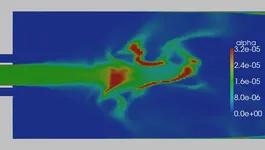Flame Dynamics of Spray Combustion
by P. Dems and Wolfgang Polifke
Background & Goals
The combustion of liquid fuels is applied to diesel engines or aero engine gas turbines since the storage of the fuel is practicable only in liquid state and space for prevaporisation is rare. Also in stationary gas turbines the combustion of liquid oil is of interest in case of bottle necks in gas supply but also in a wider context of new combustion technologies. Using liquid fuels, however, thermo-acoustic stability plays a major role in the design process, since oscillations generated by a feedback loop consisting of evaporation, combustion, heat release and acoustics lead to unstable system operation, increased emissions and also lifetime reduction or in the worst case to the total destruction of the engine. To determine the thermo-acoustical characteristic of a combustion system during the design process, experiments, espacially at high pressure, are expensive and the application of appropriate measurement techniquies often not practicable. Therefore numerical simulation plays an increasing role in the design process with its additional advantage of being applicable in a very early stage of product development. However, there is still much research needed in developing CFD tools describing thermo-acoustical stability of reacting multiphase flows accurately. The aim of this project is to contribute a numerical tool to describe the spray motion, evaporation and combustion in an accurate manner but with comparatively low computational costs.
Modelling
Common modelling of particle laden two-phase flows are based on the Euler- Lagrange description of the continuous fluid (e.g. air) and the particles (e.g. fuel droplets), where the particles motion is determined following each individual particle and modifing its motion by taking into account the impact of the surrounding fluid. In this work, however, the particles are modelled also as a continuous fluid with corresponding properties (Euler-Euler approach).

Both phases penetrate each other and exchange mass, momentum and energy due to e.g. evaporation, drag force, etc. This method has advantages in solver structure, stability, parallelisation and computational costs, however, requires complex models to account for physical processes as polydispersity (different behaviour of particles due to their different diameters) or particle trajectory crossing, for example, which can be accounted for easily in the Euler-Lagrange description. Several methods are proposed in literature and strong research has been undertaken in the last years. At the Lehrstuhl für Thermodynamik at TU Munich a Moments Model has been developed to account for polydispersity. Equations were derived by integrating the Multi-Fluid equations over the particle size spectrum, resulting in a set of equations, which describe the transport of the moments M(k) of the size distribution function ƒ(D), which are given by

with D is the particle diameter and k the order of the moment. Closure is obtained by using presumed shape functions (see for example [1,2]). This model has been extended to Large Eddy Simulation (LES) context in the current project.
Validation

The new solver has been validated against the experimental data of Sommerfeld and Qiu [3] with good agreement (picture: volume fraction of particles).
Currently, simulations including evaporation are carried out for a similar setup of Sommerfeld and Qiu [4].
Further Steps
Next steps include the implementation of a spray combustion model containing the combustion of the evaporated fuel but also the contribution of single burning droplets ignited by having entered hot gas zones or the flame front. Finally CFD/SI (system identification) methods will be applied to determine the flame and combustor transfer function, respectively, to be able to characterise the thermoacoustical behavior of the whole system and to design the engine to ensure stable operation.
References
[1] J. Carneiro and V. Kaufmann and W. Polifke. Numerical Simulation of Droplet Dispersion and Evaporation with a Moments-based CFD Model. Proceedings of COBEM,2009.
[2] J. Carneiro and P. Dems and V. Kaufmann and W. Polifke. Eulerian Simulations of Polydisperse Flows using a Moments Model with a Relaxation Approach for the Moment Transport Velocities. 7th ICMF 2010, Tampa, FL
[3] M. Sommerfeld and H.-H. Qiu. Detailed measurements in a swirling particulate twophase flow by a phase-Doppler anemometer. Int. J. Heat and Fluid Flow vol.12-1, 1991.
[4] M. Sommerfeld and H.-H. Qiu. Experimental studies of spray evaporation in turbulent flow. Int. J. Heat and Fluid Flow, vol.19, p. 10-22, 1998.